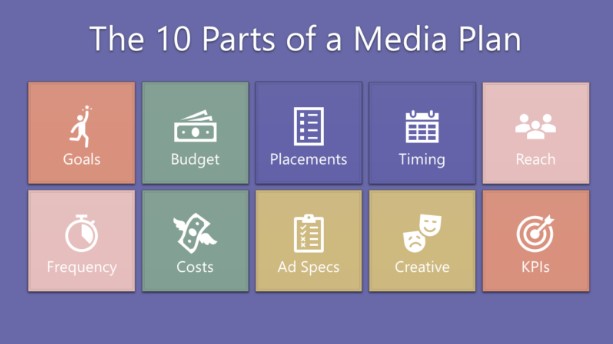
Integrated media planning is a strategic work approach in the field of advertising and marketing that involves coordinating and synchronizing different communication channels to create a unified and consistent message and deliver it to the target audience.
This type of media planning involves the careful selection and integration of multiple media platforms that can include television, radio, print, digital, social media, and outdoor advertising, among others.
The objective of integrated media planning is to create a cohesive and impactful marketing campaign that maximizes the reach and effectiveness of each channel.
By combining different media channels, businesses can achieve better brand visibility, engage with their target audience across multiple touchpoints, and ultimately drive desired actions, such as sales, conversions, or brand awareness.
Though we have highlighted the impact of integrated media planning, the question still arises, do businesses really need it? And if so, how effective these are?
Combined Effort & Consistency
Businesses need synergy and consistency because it helps establish brand recognition, build consumer trust, reinforce messaging, improve brand recall, amplify the impact of the message, enhance the customer experience, and differentiate themselves from competitors.
With different media channels working together, businesses can create a consistent and synergistic brand experience for their audience.
A cohesive message to multiple touch points reinforces brand awareness and enhances brand recall. Integrated media planning brings in that combined action and consistency in effective marketing.
Maximizing ROI
Integrated media planning also allows businesses to allocate their advertising budgets more efficiently.
By analyzing the strengths and weaknesses of different media channels, businesses can identify the effective combination of channels to reach their goals and optimize their return on investment (ROI). With an understanding of
- the demographics,
- preferences,
- and behavior of the audience
businesses can select the channels that are most relevant and effective in reaching them. This targeted approach ensures that the marketing messages are delivered to the right people, increasing the chances of generating a good ROI.
When the same message is shared across multiple media, it increases the chances of brand recall and resonates more strongly with the audience and keeps the uniformity in the brand image. This repetition further reinforces the brand’s key messages, making them more memorable and increasing the likelihood of driving desired actions that contribute to ROI.
Understanding & Adapting To Consumer Behavior
Consumers today expect a seamless brand experience across various channels. They like to connect and engage, and that’s where integrated media planning enables businesses to adapt to consumer behavior and engage with their audience on the platforms they frequent. This leads to enhancing customer satisfaction and building stronger brand relationships.
Media planning helps businesses adapt to consumer behavior by having a multi-channel presence, selecting the most relevant channels, delivering a consistent brand experience, personalizing messaging, and leveraging consumer insights.
By understanding and aligning with consumer behavior, businesses can greatly engage with their target audience and meet their evolving expectations, ultimately driving better results and success.
Optimization Of Resources
Integrated media planning helps businesses optimize their resources and advertising budgets.
By analyzing the strengths and weaknesses of different media channels, SEO practices, businesses can allocate their resources more efficiently, focusing on the channels that offer the greatest potential for reaching their target audience and achieving their marketing objectives.
The planning helps identify redundancies or overlapping efforts across different channels. By coordinating and aligning the messaging and timing of campaigns, businesses can avoid duplicate efforts and unnecessary costs. This ensures that resources are utilized effectively, eliminating wasteful spending and optimizing the overall efficiency of the marketing efforts.
Audience Fragmentation
Audience fragmentation is a process where consumers are increasingly divided and scattered across various media channels and platforms. In the past, traditional media channels such as television, radio, and print had a more dominant presence, allowing businesses to reach a large portion of their target audience through a few key channels.
However, with the advent of digital media and the rise of numerous online platforms, consumers now have a wide range of options for accessing content and engaging with brands.
The implications of audience fragmentation for businesses are significant. It means that reaching and engaging with the target audience has become more challenging. Businesses need to adapt their marketing strategies to reach and connect with consumers across multiple channels.
Integrated media plans play a crucial role in addressing audience fragmentation by identifying the relevant media channels and creating cohesive and coordinated marketing campaigns that cut through the noise and deliver a unified message to the fragmented audience.
Increased Impact
When multiple media channels work together, they amplify the impact of the marketing message. By utilizing different channels in a coordinated manner, businesses can reinforce their messaging, increase exposure frequency, and enhance the overall effectiveness of their campaigns.
Different channels attract different segments of the audience, and by integrating efforts across various channels, businesses can maximize their reach and exposure. This expanded reach increases the chances of connecting with a larger audience and generating a greater impact. Also enhancing overall customer experience, making it more positive and memorable.
When customers have a consistent and unified experience with a brand, it increases their satisfaction and loyalty, leading to a stronger impact on their purchasing decisions and brand advocacy.
In summary, integrated media planning leads to increased impact by ensuring message consistency and reinforcement, expanding reach, leveraging the synergy between channels, enhancing the customer experience, providing multiple touchpoints for engagement, and optimizing strategies based on data insights.
By integrating efforts across various media channels, businesses can achieve a greater impact on their target audience and achieve their marketing objectives more effectively.
Read Also:






